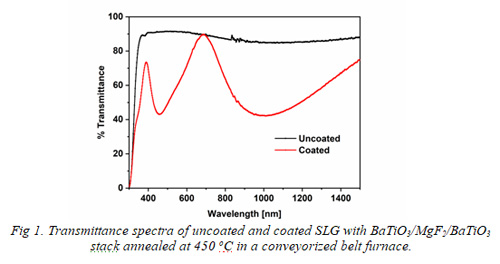 Researchers from International Advanced Research Centre for Powder Metallurgy & New Materials (ARCI), an autonomous R&D Centre of Department of Science and Technology, Government of India, have developed a cost-effective, fully- dielectric solar control coating on glass that can reduce air conditioning load on vehicles and buildings.
Researchers from International Advanced Research Centre for Powder Metallurgy & New Materials (ARCI), an autonomous R&D Centre of Department of Science and Technology, Government of India, have developed a cost-effective, fully- dielectric solar control coating on glass that can reduce air conditioning load on vehicles and buildings.Glass is extensively used in architectural and automobile sectors both for aesthetic appeal as well as a protective material from adverse atmospheric conditions while maintaining transparency for daylight illumination. However, it is the largest source of heat penetration and does not render protection from ultraviolet (UV) and near-infrared (NIR) radiation, leading to an increase in the load of comfort air conditioning. This is a cause for serious concern, more so in tropical countries like India. Blocking the harmful UV radiation as well as NIR radiation without hampering the visible light transmittance is possible by suitable engineering of the glass surface, either by way of solar control films or by depositing solar control coatings.
However, solar control films, that are mostly polymer-based are not adequately durable due to their poor scratch resistance and reactivity with UV radiation. Moreover, they are banned for use in automobile windows in India for security reasons. IR reflective coatings based on metal-dielectric stacks have been proposed as an alternate solution. However, these systems need to be protected from environment due to softness and reactivity of the metallic layers to oxygen and humidity. Transparent conducting oxide (TCO) films based on Indium tin oxide have also been investigated as suitable alternates, but their high cost and depleting reserves of indium, calls for a suitable replacement.

In view of the above, researchers from ARCI have developed a cost-effective fully- dielectric solar control coating on glass that comprises multilayered stacks of alternate high refractive index materials (HI) like metal titanates and low refractive index materials (LI) like MgF2 of specified thickness and refractive index, that yield optimized solar control properties, while maintaining a highly visible light transmittance.
Barium titanate (BaTiO3) was used as the high refractive index material and MgF2 as the low refractive index material to generate the fully dielectric coating stack. Three-layered stack of BaTiO3/MgF2/BaTiO3 was generated by a sol-gel technique using BaTiO3 and MgF2 sols deposited on soda-lime glass (SLG) after employing optimized dip-coating parameters. The multilayered coating stack was fired at 450oC using a conveyorized belt furnace for very fast heating. The coating stack after firing showed a considerable amount of near-infrared (NIR) blocking, NIR (800-1500 nm) transmittance of 55%, and 67% visible light (400-800 nm) transmittance, compared to 86 % and 90 % respectively for the bare glass.
Experiments show that this multilayered solar control coating will have immense potential to reduce the load on air conditioning for the automotive and architectural industries. An Indian patent application has also been filed to protect the know-how, which is currently under examination.
“In India, where much of the air conditioning load is for cooling rather than heating, we need windows that let in light while cutting down on transmission of heat. The material developed at ARCI, as well as a plethora of other building materials being designed, addresses the problem of efficient cooling in homes and offices,” said Prof Ashutosh Sharma, Secretary, DST.
Publications and Patents:
- Indian patent application number 201811024034 dtd 27/06/2018
- https://doi/org/10/1007/s11164-019-03899-w
- Effect of heat treatment on the optical properties of sol-gel derived fully dielectric solar control coatings on glass, S. Manasa and R. Subasri, J Coatings Technology & Research, 13 (2016) 623-628.
For more details, contact Dr. R. Subasri (subasri[at]arci[dot]res[dot]in).






























